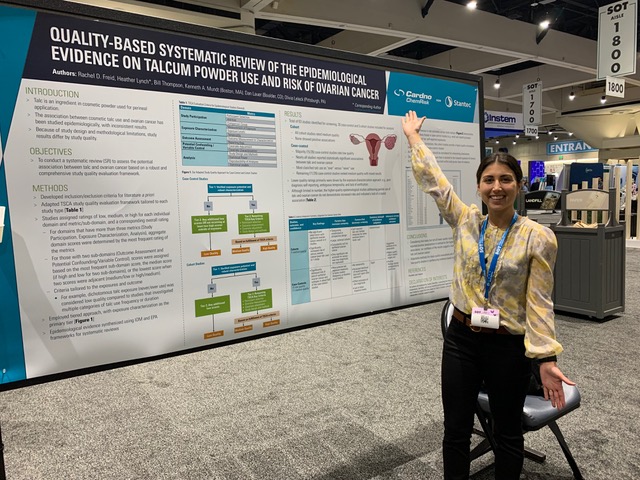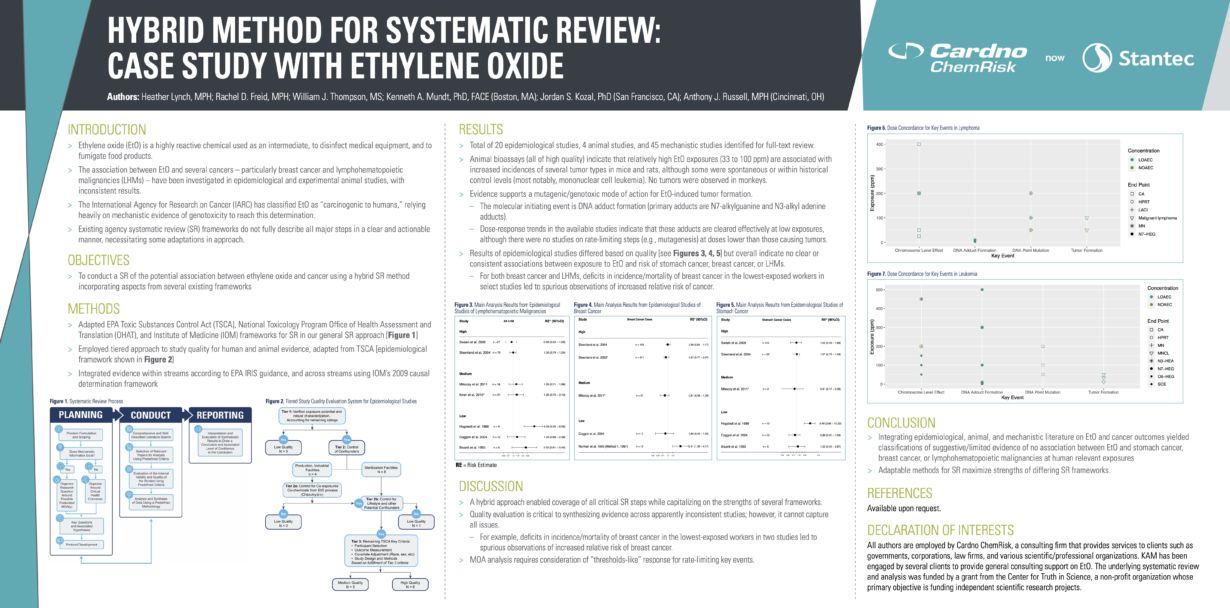Congratulations to all the Center-funded independent scientists who presented their posters at the annual Society of Toxicology conference!
Scientific posters based on three Center-funded independent critical and systematic reviews were presented at this year’s Society of Toxicology meeting in San Diego, CA:
- Quality-Based Systematic Review of the Epidemiological Evidence on Talcum Powder Use and Risk of Ovarian Cancer
- Hybrid Method for Systematic Review: Case Study with Ethylene Oxide
- Meta-analyses of Glyphosate and Non-Hodgkin’s Lymphoma: Expert Panel Conclusions and Recommendations
All three poster sessions enjoyed a great turnout of conference attendees, including scientists, academics, and industry representatives. Most of the discussion was very positive with good questions, supportive comments, and productive suggestions.
Manuscripts for all three projects have been submitted for publication and are under review at peer-reviewed journals. Below are some highlights of the methods and important findings that were presented in the posters, for those not present:
Quality-Based Systematic Review of the Epidemiological Evidence on Talcum Powder Use and Risk of Ovarian Cancer
Rachel D. Freid, MPH; Heather Lynch, MPH; Bill Thompson, MS; Dan Lauer, MPH; Olivia Leleck, MPH, CPH; Kenneth A. Mundt, Ph.D., FACE

- Inclusion and exclusion criteria for studies in the review were established a priori.
- Epidemiological, experimental animal, and mechanistic (invivo, mammalian, or bacterial cell lines) studies were included.
- Case studies and case series were excluded.
- Studies pertaining to mixtures and oral/dermal exposure were excluded.
- An adapted Toxic Substances Control Act (TSCA) quality evaluation framework that employed a tiered approach tailored to each study type and outcome was used, where exposure characterization was the primary tier.
- Evidence from medium and high quality studies was synthesized using a hybrid combination incorporating aspects of the Institute of Medicine, several EPA frameworks for systematic reviews, and EPA’s application of systematic reviews in TSCA risk evaluations.
- Sixty-three epidemiological studies were initially identified, and 26 case-control and five cohort studies were ultimately included.
- All of the prospective cohort studies were rated medium quality and found no association between talcum powder use and ovarian cancer.
- While 15 in 26 case-control studies reported statistically significant associations, all were rated low quality due to recall and self-reporting biases. Eleven in 26 studies were rated medium quality and none were rated high quality.
- The subset of better quality epidemiological studies combined with evidence of bias found in the lower quality ones suggest the lack of a causal connection.
Hybrid Method for Systematic Review: Case Study with Ethylene Oxide
Heather Lynch, MPH; Jordan Kozal, Ph.D.; Anthony Russell, MPH; Rachel D. Freid, MPH; William Thompson, MS; Kenneth A. Mundt, Ph.D., FACE

- There are many approaches for systematic review in chemical risk assessment, each with strengths and limitations.
- This work combined the strongest aspects of frameworks developed by the EPA Integrated Risk Information System, and the Institute of Medicine to conduct a systematic review of the literature to evaluate evidence of ethylene oxide carcinogenicity.
- Twenty-six primary epidemiology and experimental animal studies were found, as well as 45 mechanistic studies.
- The mechanistic studies demonstrated a genotoxic mode of action.
- The toxicology studies demonstrated carcinogenicity in animals.
- These studies were conducted with higher doses than most human exposures.
- In the mechanistic studies, there was no information available on rate limiting key events in the mode of action in the low-dose region.
- There was no evidence of increased cancer risk in the epidemiological studies, particularly in recent occupational cohort studies.
- The study authors conclude suggestive evidence of no association between ethylene oxide and stomach cancer or breast cancer at human-relevant exposure.
- There is limited evidence of no-association between ethylene oxide and any specific lymphohematopoietic cancers at human-relevant exposures (acknowledging there are very few studies of the same specific lymphohematopoietic cancers).
Meta-analyses of Glyphosate and Non-Hodgkin’s Lymphoma: Expert Panel Conclusions and Recommendations
C.R. Kirman, MS; Hayes, Ph.D.

- The researchers conducted an independent review of published meta- and pooled analyses for the exposures to glyphosate and non-Hodgkin’s lymphoma.
- A panel of six experts in epidemiology and meta-analysis was assembled to support a review of a series of recent publications using a modified Delphi format.
- The review was double-blinded: the review funder was blinded to the panelists’ identities, and the panelists were blinded to the identities of the funder and fellow panel members.
- Seven meta- or pooled analyses were identified from the published literature.
- These publications were scored based on a consideration of confidence in their methods, results, conclusions, and applicability to risk-based decision making.
- Mean confidence scores for the papers reviewed ranged from 53 to 74 (with a maximum score of 100), and key strengths and concerns were identified.
- This expert panel review highlights the need for transparency in meta-analyses.
- Different conclusions were reached in available meta-analyses because of varying criteria used to select studies, selection of different risk estimates within the same study, and study availability.
- The expert panel concluded that confidence in a causal relationship between glyphosate exposure and Non-Hodgkin’s Lymphoma was considered low.